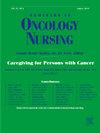吲哚菁绿淋巴造影术在保守性淋巴水肿治疗中的应用:探讨对淋巴水肿治疗方案的影响。
IF 2.3
4区 医学
Q1 NURSING
引用次数: 0
摘要
目的:吲哚菁绿(ICG)淋巴造影(ICG- l)信息可用于指导个人淋巴水肿治疗计划。然而,这种临床转化的机制并没有很好地描述。本研究提出了一种新的临床决策支持工具,用于将ICG-L结果转化为个体化淋巴水肿治疗计划,并描述了手动淋巴引流和压迫计划特征的后续变化。方法:本研究比较了肢体淋巴水肿患者进行ICG-L前后的具体治疗方案特征。在参与者接受了ICG-L后,使用一种新的临床决策支持工具ICG-TRANSLATE,将个体的ICG-L结果转化为ICG-L知情的治疗计划。预先确定的编码树用于识别手动淋巴引流和压缩治疗方案建议元素的变化。结果:应用ICG-TRANSLATE决策支持工具后,100% (n = 25)的参与者改变了手工淋巴引流建议,包括终端淋巴结、通路和技术的要素。此外,88% (n = 22)的人改变了压缩建议,最常见的是改变了服装的肢体覆盖范围。结论:ICG-L的发现改变了传统的手工淋巴引流和压迫的淋巴水肿治疗方案。这种个体化治疗建议的改变是否会改善淋巴水肿的预后还需要进一步的研究。对护理实践的影响:临床决策支持工具可以帮助从业者将ICG-L结果转化为淋巴水肿患者的个性化淋巴水肿治疗计划。进一步的探索是必要的,以确定是否通过icg - l知情的治疗方案所带来的管理改变改善了淋巴水肿患者的预后。本文章由计算机程序翻译,如有差异,请以英文原文为准。
Indocyanine Green Lymphography in Conservative Lymphedema Management: An Exploration of the Impact on Lymphedema Therapy Plans
Objectives
Information from indocyanine green (ICG) lymphography (ICG-L) can be used to guide an individual's lymphedema therapy plan. However, the mechanisms for this clinical translation are not well described. This study proposes a novel clinical decision support tool for translating ICG-L findings into individualized lymphedema therapy plans and describes subsequent changes in plan features of manual lymphatic drainage and compression.
Methods
This before-after study compared specific therapy plan features before and after ICG-L for participants with limb lymphedema. After participants had undergone ICG-L, the individuals’ ICG-L findings were translated into an ICG-L–informed therapy plan using a novel clinical decision support tool, ICG-TRANSLATE. A predetermined coding tree was used to identify changes in elements of manual lymphatic drainage and compression therapy plan recommendations.
Results
Following the application of the ICG-TRANSLATE decision support tool, 100% (n = 25) of participants had a change in manual lymphatic drainage recommendations, including elements of terminal nodes, pathway, and technique. Additionally, 88% (n = 22) had a change in compression recommendations, which was most commonly a change in garment limb coverage.
Conclusions
ICG-L findings informed changes to traditional lymphedema therapy plan modalities of manual lymphatic drainage and compression. Whether this change to individual therapy recommendations translates into improved lymphedema outcomes requires further investigation.
Implications for Nursing Practice
A clinical decision support tool may assist practitioners in translating ICG-L findings into individualized lymphedema therapy plans for people with lymphedema. Further exploration is necessary to determine if the management changes derived through ICG-L–informed therapy plans improve outcomes for people with lymphedema.
求助全文
通过发布文献求助,成功后即可免费获取论文全文。
去求助
来源期刊

Seminars in Oncology Nursing
Nursing-Oncology (nursing)
CiteScore
3.40
自引率
0.00%
发文量
68
审稿时长
45 days
期刊介绍:
Seminars in Oncology Nursing is a unique international journal published six times a year. Each issue offers a multi-faceted overview of a single cancer topic from a selection of expert review articles and disseminates oncology nursing research relevant to patient care, nursing education, management, and policy development.
 求助内容:
求助内容: 应助结果提醒方式:
应助结果提醒方式:


